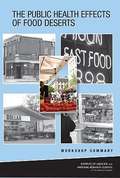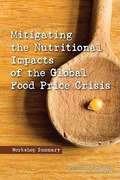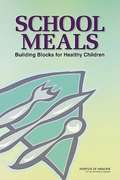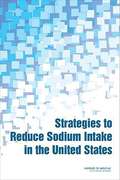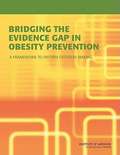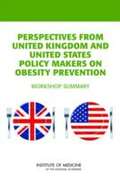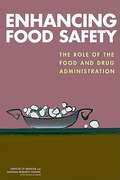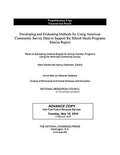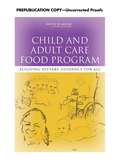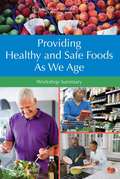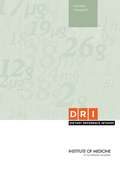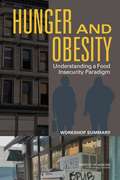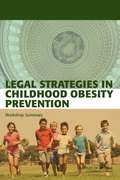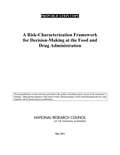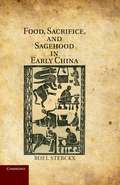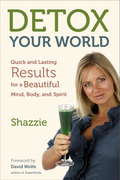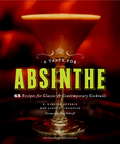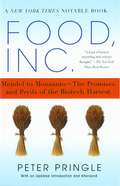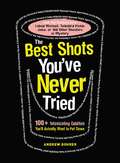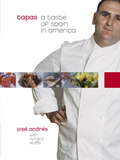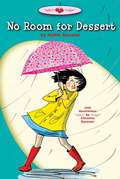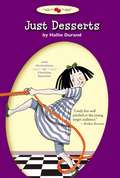- Table View
- List View
The Public Health Effects of Food Deserts: Workshop Summary
by Institute of Medicine National Research Council of the National AcademiesThis report from the January 2009 workshop examines neighborhoods and communities that have limited access to affordable and nutritious foods, and describes several approaches to measuring food deserts and their impact on public health. Researchers from the US and Britain evaluate different interventions to ameliorate food desert conditions and identify current research gaps and needs. No index is provided. Annotation ©2010 Book News, Inc. , Portland, OR (booknews. com)
Mitigating the Nutritional Impacts of the Global Food Price Crisis: Workshop Summary
by Institute of Medicine of the National AcademiesIn 2007 and 2008, the world witnessed a dramatic increase in food prices. The global financial crisis that began in 2008 compounded the burden of high food prices, exacerbating the problems of hunger and malnutrition in developing countries. The tandem food price and economic crises struck amidst the massive, chronic problem of hunger and undernutrition in developing countries. National governments and international actors have taken a variety of steps to mitigate the negative effects of increased food prices on particular groups. The recent abrupt increase in food prices, in tandem with the current global economic crisis, threatens progress already made in these areas, and could inhibit future efforts. The Institute of Medicine held a workshop, summarized in this volume, to describe the dynamic technological, agricultural, and economic issues contributing to the food price increases of 2007 and 2008 and their impacts on health and nutrition in resource-poor regions. The compounding effects of the current global economic downturn on nutrition motivated additional discussions on these dual crises, their impacts on the nutritional status of vulnerable populations, and opportunities to mitigate their negative nutritional effects.
School Meals: Building Blocks for Healthy Children
by Institute of MedicineEnsuring that the food provided to children in schools is consistent with current dietary recommendations is an important national focus. Various laws and regulations govern the operation of school meal programs. In 1995, Nutrition Standards and Meal Requirements were put in place to ensure that all meals offered would be high in nutritional quality. School Meals reviews and provides recommendations to update the nutrition standard and the meal requirements for the National School Breakfast and Lunch Programs. The recommendations reflect new developments in nutrition science, increase the availability of key food groups in the school meal programs, and allow these programs to better meet the nutritional needs of children, foster healthy eating habits, and safeguard children's health. School Meals sets standards for menu planning that focus on food groups, calories, saturated fat, and sodium and that incorporate Dietary Guidelines for Americans and the Dietary Reference Intakes. This book will be used as a guide for school food authorities, food producers, policy leaders, state/local governments, and parents.
Strategies to Reduce Sodium Intake in the United States
by Institute of Medicine of the National AcademiesReducing the intake of sodium is an important public health goal for Americans. Since the 1970s, an array of public health interventions and national dietary guidelines has sought to reduce sodium intake. However, the U.S. population still consumes more sodium than is recommended, placing individuals at risk for diseases related to elevated blood pressure.Strategies to Reduce Sodium Intake in the United States evaluates and makes recommendations about strategies that could be implemented to reduce dietary sodium intake to levels recommended by the Dietary Guidelines for Americans. The book reviews past and ongoing efforts to reduce the sodium content of the food supply and to motivate consumers to change behavior. Based on past lessons learned, the book makes recommendations for future initiatives. It is an excellent resource for federal and state public health officials, the processed food and food service industries, health care professionals, consumer advocacy groups, and academic researchers.
Bridging the Evidence Gap in Obesity Prevention: A Framework to Inform Decision Making
by Institute of Medicine of the National AcademiesTo battle the obesity epidemic in America, health care professionals and policymakers need relevant, useful data on the effectiveness of obesity prevention policies and programs. ridging the Evidence Gap in Obesity Prevention identifies a new approach to decision making and research on obesity prevention to use a systems perspective to gain a broader understanding of the context of obesity and the many factors that influence it.
Perspectives from United Kingdom and United States Policy Makers on Obesity Prevention: Workshop Summary
by Institute of Medicine of the National AcademiesBoth the United Kingdom and United States are grappling with nationwide epidemics of obesity. Obesity contributes to diabetes, cardiovascular disease, and some cancers, among other diseases. Although many people are aware of obesity's causes and consequences, few see it as a problem for their own families--despite clinical evidence to the contrary. Given this disconnect between perception and reality, policy makers in both countries struggle to find a way to reach people to encourage change. The IOM brought together policy makers from the U.K. and U.S. for a workshop on October 22, 2009, to discuss the challenges of and promising approaches to the struggle against obesity. Presenters spoke about current policies, programs, and partnerships that are addressing the obesity epidemic and evidence for effective strategies to change perception and behaviors. The workshop, summarized in this document, provided an opportunity for both countries to learn from each other's efforts and to consider how to apply new strategies at home.
Enhancing Food Safety: The Role of the Food and Drug Administration
by Institute of Medicine National Research Council of the National AcademiesRecent outbreaks of illnesses traced to contaminated sprouts and lettuce illustrate the holes that exist in the system for monitoring problems and preventing foodborne diseases. Although it is not solely responsible for ensuring the safety of the nation's food supply, the U.S. Food and Drug Administration (FDA) oversees monitoring and intervention for 80 percent of the food supply. The U.S. Food and Drug Administration's abilities to discover potential threats to food safety and prevent outbreaks of foodborne illness are hampered by impediments to efficient use of its limited resources and a piecemeal approach to gathering and using information on risks. Enhancing Food Safety: The Role of the Food and Drug Administration, a new book from the Institute of Medicine and the National Research Council, responds to a congressional request for recommendations on how to close gaps in FDA's food safety systems. Enhancing Food Safety begins with a brief review of the Food Protection Plan (FPP), FDA's food safety philosophy developed in 2007. The lack of sufficient detail and specific strategies in the FPP renders it ineffectual. The book stresses the need for FPP to evolve and be supported by the type of strategic planning described in these pages. It also explores the development and implementation of a stronger, more effective food safety system built on a risk-based approach to food safety management. Conclusions and recommendations include adopting a risk-based decision-making approach to food safety; creating a data surveillance and research infrastructure; integrating federal, state, and local government food safety programs; enhancing efficiency of inspections; and more. Although food safety is the responsibility of everyone, from producers to consumers, the FDA and other regulatory agencies have an essential role. In many instances, the FDA must carry out this responsibility against a backdrop of multiple stakeholder interests, inadequate resources, and competing priorities. Of interest to the food production industry, consumer advocacy groups, health care professionals, and others, Enhancing Food Safety provides the FDA and Congress with a course of action that will enable the agency to become more efficient and effective in carrying out its food safety mission in a rapidly changing world.
Developing and Evaluating Methods for Using American Community Survey Data to Support the School Meals Programs: Interim Report
by National Research Council of the National AcademiesThe National School Lunch Program and the School Breakfast Program, administered by the Food and Nutrition Service of the U.S. Department of Agriculture (USDA), are key components of the nation's food security safety net, providing free or low-cost meals to millions of school-age children each day. Under the most commonly adopted provisions, USDA reimburses districts for meals served on the basis of data collected in a "base year
Child and Adult Care Food Program: Aligning Dietary Guidance for All
by Institute of Medicine of the National AcademiesThe Child and Adult Care Food Program (CACFP) is a federally-funded program designed to provide healthy meals and snacks to children and adults while receiving day care at participating family day care homes, traditional child care centers, afterschool facilities, adult care facilities, and emergency shelters. CACFP has the broadest scope of any of the U.S. Department of Agriculture (USDA) food program, serving more than 3 million children and 114,000 adults across the nation. To receive reimbursement for the foods served, participating programs must abide by requirements set by the USDA. Child and Adult Care Food Program assesses the nutritional needs of the CACFP population based on Dietary Guidelines for Americans and the Dietary Reference Intakes (DRIs) and makes recommendations for revisions to the CACFP meal requirements. The book outlines meal requirements that include food specifications that could be used for specific meals and across a full day, covering all age groups from infants to older adults and meal patterns designed for use in a variety of settings, including in-home care and in large centers. By implementing these meal requirements, consumption of fruits, vegetables, and whole-grain rich foods will increase while consumption of solid fats, added sugars, and sodium will decrease. Not only will this address the high prevalence of childhood obesity, it will also help to achieve consistency with the standards and regulations of other USDA nutrition assistance programs, particularly the Supplemental Nutrition Program for Women, Infants, and Children (WIC), and the National School Lunch and School Breakfast programs. Child and Adult Care Food Program makes practical recommendations that would bring CACFP meals and snacks into alignment with current dietary guidance. The book will serve as a vital resource for federal and state public health officials, care providers working in child and adult day care facilities, WIC agencies, officials working with the National School Lunch and School Breakfast programs, and other organizations serving at-risk populations.
Providing Healthy and Safe Foods As We Age: Workshop Summary
by Institute of Medicine of the National AcademiesDoes a longer life mean a healthier life? The number of adults over 65 in the United States is growing, but many may not be aware that they are at greater risk from foodborne diseases and their nutritional needs change as they age. The IOM's Food Forum held a workshop October 29-30, 2009, to discuss food safety and nutrition concerns for older adults.
DRI Dietary Reference Intakes Calcium Vitamin D
by Institute of Medicine of the National AcademiesCalcium and vitamin D are essential nutrients for the human body. Establishing the levels of these nutrients that are needed by the North American population is based on the understanding of the health outcomes that calcium and vitamin D affect. It is also important to establish how much of each nutrient may be "too much." Dietary Reference Intakes for Calcium and Vitamin D provides reference intake values for these two nutrients. The report updates the DRI values defined in Dietary Reference Intakes for Calcium, Phosphorous, Magnesium, Vitamin D, and Fluoride, the 1997 study from the Institute of Medicine. This 2011 book provides background information on the biological functions of each nutrient, reviews health outcomes that are associated with the intake of calcium and vitamin D, and specifies Estimated Average Requirements and Recommended Dietary Allowances for both. It also identifies Tolerable Upper Intake Levels, which are levels above wish the risk for harm may increase. The book includes an overview of current dietary intake in the U.S. and Canada, and discusses implications of the study. A final chapter provides research recommendations. The DRIs established in this book incorporate current scientific evidence about the roles of vitamin D and calcium in human health and will serve as a valuable guide for a range of stakeholders including dietitians and other health professionals, those who set national nutrition policy, researchers, the food industry, and private and public health organizations and partnerships.
Hunger and Obesity: Understanding a Food Insecurity Paradigm - Workshop Summary
by Institute of Medicine of the National AcademiesAt some point during 2009, more than 17 million households in the United States had difficulty providing enough food for all their members because of a lack of resources. In more than one-third of these households, the food intake of some household members was reduced and normal eating patterns were disrupted due to limited resources. The Workshop on Understanding the Relationship Between Food Insecurity and Obesity was held to explore the biological, economic, psychosocial, and other factors that may influence the relationship between food insecurity, overweight, and obesity in the United States. Hunger and Obesity examines current concepts and research findings in the field. The report identifies information gaps, proposes alternative approaches to analyzing data, recommends new data that should be collected, and addresses the limitations of the available research.
Legal Strategies in Childhood Obesity Prevention
by The National Academy of SciencesSince 1980, childhood obesity rates have more than tripled in the United States. Recent data show that almost one-third of children over 2 years of age are already overweight or obese. While the prevalence of childhood obesity appears to have plateaued in recent years, the magnitude of the problem remains unsustainably high and represents an enormous public health concern. All options for addressing the childhood obesity epidemic must therefore be explored. In the United States, legal approaches have successfully reduced other threats to public health, such as the lack of passive restraints in automobiles and the use of tobacco. The question then arises of whether laws, regulations, and litigation can likewise be used to change practices and policies that contribute to obesity. On October 21, 2010, the Institute of Medicine (IOM) held a workshop to bring together stakeholders to discuss the current and future legal strategies aimed at combating childhood obesity. Legal Strategies in Childhood Obesity Preventionsummarizes the proceedings of that workshop. The report examines the challenges involved in implementing public health initiatives by using legal strategies to elicit change. It also discusses circumstances in which legal strategies are needed and effective. This workshop was created only to explore the boundaries of potential legal approaches to address childhood obesity, and therefore, does not contain recommendations for the use of such approaches.
A Risk-Characterization Framework for Decision-Making at the Food and Drug Administration
by National Research Council of the National AcademiesWith the responsibility to ensure the safety of food, drugs, and other products, the U.S. Food and Drug Administration (FDA) faces decisions that may have public-health consequences every day. Often the decisions must be made quickly and on the basis of incomplete information. FDA recognized that collecting and evaluating information on the risks posed by the regulated products in a systematic manner would aid in its decision-making process. Consequently, FDA and the Department of Health and Human Services (DHHS) asked the National Research Council (NRC) to develop a conceptual model that could evaluate products or product categories that FDA regulates and provide information on the potential health consequences associated with them. A Risk-Characterization Framework for Decision-Making at the Food and Drug Administration describes the proposed risk-characterization framework that can be used to evaluate, compare, and communicate the public-health consequences of decisions concerning a wide variety of products. The framework presented in this report is intended to complement other risk-based approaches that are in use and under development at FDA, not replace them. It provides a common language for describing potential public-health consequences of decisions, is designed to have wide applicability among all FDA centers, and draws extensively on the well-vetted risk literature to define the relevant health dimensions for decision-making at the FDA. The report illustrates the use of that framework with several case studies, and provides conclusions and recommendations.
Food, Sacrifice, and Sagehood in Early China
by Roel SterckxIn ancient China, the preparation of food and the offering up of food as a religious sacrifice were intimately connected with models of sagehood and ideas of self-cultivation and morality. Drawing on received and newly excavated written sources, Roel Sterckx's book explores how this vibrant culture influenced the ways in which the early Chinese explained the workings of the human senses, and the role of sensory experience in communicating with the spirit world. The book, which begins with a survey of dietary culture from the Zhou to the Han, offers intriguing insights into the ritual preparation of food - some butchers and cooks were highly regarded and would rise to positions of influence as a result of their culinary skills - and the sacrificial ceremony itself. As a major contribution to the study of early China and to the development of philosophical thought, the book will be essential reading for students of the period, and for anyone interested in ritual and religion in the ancient world.
The Only Diet Book You'll Ever Need
by Cyndi TargoszD -iscouraged with the way you look? I -nterested in long-term results? E -xcited for the new and improved you? T -ime to get a move on! Tired of the roller-coaster ride called dieting ? You are not alone! Now, with nationally celebrated weight-loss expert Cyndi Targosz as your guide, you can say goodbye to fly-by-night fad diets, create a real plan for losing-and keeping off-the weight, and have a great time doing it! Complete with tips and tricks for curbing your cravings, personalizing your plan of attack, and embracing your new delicious life, you'll be on the track to a better you in no time. With Cyndi's Secrets' for success, you will learn how to: Find out the real reason you're overweight Adapt the new Food Pyramid to your nutritional needs Shop, cook, and dine (in or out) and stay on course Let Cyndi and her one-of-a-kind program refresh, inspire, and energize you. With The Only Diet Book You'll Ever Need, your new life starts today. What are you waiting for?
Detox Your World
by David Wolfe ShazzieIn this complete detox guide, Shazzie identifies the most dangerous toxins in your environment and provides detailed detox plans and over 100 raw-food recipes to help you stay clean and healthy. If you've eaten a typical Western diet (whether meat-based or vegetarian) all your life, you will eventually start to feel under the weather, depressed, overweight, or ill. By lightening your diet and shedding the toxins accumulated from your environment, you can alleviate and even remove these problems from your life. You will be amazed at the results: * Enthusiasm for life * Deep happiness and bliss * A clearer and calmer mind * More energy than you had as a child * Natural weight loss and maintenance * Flawless skin, great muscle tone, and a younger appearanceFrom the Trade Paperback edition.
A Taste for Absinthe
by Dale Degroff James F. Thompson R. Winston Guthrie Liza GershmanAbsinthe's renaissance is quickly growing into a culinary movement. The "Green Fairy" is now showing up on cocktail menus at chic restaurants around the country. A Taste for Absinthe celebrates this storied and complex liquor by bringing you 65 cocktail recipes from America's hottest mixologists to enjoy as you discover the spirit that has fascinated artists, musicians, and writers for centuries.Absinthe expert R. Winston Guthrie shares the intriguing history of this famous beverage and a wide range of absinthe cocktails crafted by celebrated bartenders such as Jim Meehan of New York's PDT, Erik Adkins of San Francisco's Slanted Door, and Eric Alperin of The Varnish in Los Angeles. In addition to the recipes--such as the Salute to Sazerac (with rye whiskey, Angostura bitters, and lemon peel) and the Green Goddess (fresh basil leaves, cucumber vodka, simple syrup, line juice, and fresh thyme)--you will find: - a primer on the accoutrements (spoons, glasses, fountains) for serving absinthe- a how-to on executing your own absinthe drip- a guide to buying the best-quality absinthe (whether imported or domestic)- a lesson on how to discern between real absinthe and fake - sidebars on absinthe's rich history Whether you want to learn everything you need to know to host "L'Heure Verte" (the Green Hour) and impress your friends with your beautiful accoutrements and practiced pouring technique, or just make a really delicious drink, A Taste for Absinthe will bring you up to speed on the most talked about liquor in history.
Food, Inc.
by Peter PringleFor most people, the global war over genetically modified foods is a distant and confusing one. The battles are conducted in the mystifying language of genetics. A handful of corporate "life science" giants, such as Monsanto, are pitted against a worldwide network of anticorporate ecowarriors like Greenpeace. And yet the possible benefits of biotech agriculture to our food supply are too vital to be left to either partisan. The companies claim to be leading a new agricultural revolution that will save the world with crops modified to survive frost, drought, pests, and plague. The greens warn that "playing God" with plant genes is dangerous. It could create new allergies, upset ecosystems, destroy biodiversity, and produce uncontrollable mutations. Worst of all, the antibiotech forces say, a single food conglomerate could end up telling us what to eat. In Food, Inc., acclaimed journalist Peter Pringle shows how both sides in this overheated conflict have made false promises, engaged in propaganda science, and indulged in fear-mongering. In this urgent dispatch, he suggests that a fertile partnership between consumers, corporations, scientists, and farmers could still allow the biotech harvest to reach its full potential in helping to overcome the problem of world hunger, providing nutritious food and keeping the environment healthy.
Recreational Vehicle Cookbook
by Charlotte DawsonIn her RECREATIONAL VEHICLE COOKBOOK Charlotte Dawson has collected some of the favorite recipes of fascinating people she and her husband have met on their travels throughout the United States. While most of the recipes lend themselves beautifully to recreational cooking because of their simplicity they are far from commonplace. Molasses pie, Sabattus stew, swamp cabbage, corn custard, Johnny Johnson's chili concoction and recipes from the Ladies' Auxiliary of the Hatteras Volunteer Fire Department are only a sampling of the many, many unusual recipes you will find between theese covers. Mrs. Dawson has organized her cookbook into regions of America. Represented are New England, the Middle Atlantic States, Southeast, Pacific Northwest and the Southwest. Also included are a host of recipes that are delicious just about everywhere.
The Best Shots You've Never Tried
by Andrew BohrerSick of the same ol' shots? Raise the bar! Bored to tears with tequila shooters? Kamikazes make you wanna go all hari kari? Time to turn your Friday nights up a notch with The NoLita, test your limits on the Whiskey Buck Hunter, and make happy hour that much happier with a Double Entendre. In this homage to booze and creativity, mixologist Andrew Bohrer combines his bartending knowledge with his flair for the dramatically creative to invent more than 100 recipes for shots you've never, ever tried--or even heard of--along with a photo of each and every crazy concoction. Whether you're in the mood for a banger and slammer, a shot apropos for the dinner table, or the perfect shot to raise in tribute and solidarity at the ultimate drinking event (an after-funeral get-together),The Best Shots You've Never Triedis sure to be the most fun you'll ever have, 1 1/2 ounces at a time.
Tapas
by Richard Wolffe Jose AndresThe first major Spanish cookbook in two decades, from José Andrés, recently named America's Chef of the Year by Bon Appétit.Tapas are Spain's gift to the world of great cooking: a fresh and fun way to eat with friends and family--and easy to make at home. Using simple Mediterranean ingredients, a tapas feast is a perfect combination of little dishes packed with big flavors. Tapas by José Andrés is the first major book in a generation to celebrate this world-renowned way of eating, from a man who is the best possible authority: an award-winning Spanish chef in America, with seven highly acclaimed restaurants to his name. Recently named Bon Appétit's Chef of the Year, José is a new star in American cooking, as well as the nation's leading expert on Spanish cuisine. Having worked as a chef in the United States for two decades, he's also a thoroughly American cook who draws on American ingredients for his inspiration, and is a master at translating his native Spanish cooking for this country's kitchens. His simple and delicious recipes include:* Fish such as American Red Snapper Baked in Salt; Monkfish with Romesco Sauce; and Basque-Style Stuffed Maryland Blue Crabs* Chicken including Catalan-Style Chicken Stew; Chicken Sautéed with Garlic; and Chicken with Lobster* Pork such as Chorizo Stewed in Hard Cider; Figs with Spanish Ham; and Roasted Pork Tenderloin with Apples * Rice dishes including Lobster Paella; Black Rice with Squid and Shrimp; and Traditional Rice with Clams All these recipes are full of tremendous flavor and creativity, as well as in-depth ingredient notes and a rich atmosphere that will transport you to the lush countryside, hip cafés, and sun-drenched coasts of Spain--and back again to dinner at home. This is a breakthrough cookbook from an extraordinary chef.
No Room for Dessert
by Christine Davenier Hallie DurandWith virtually no warning, it seems like Dessert's life story is being written in invisible ink. Nobody in the Schneider house seems to remember she exists. Her school picture hanging on the fridge? Covered. The promise of burritos? Forgotten. And her baby brother doesn't even know her name. (He calls her "dirt.") Dessert wants to get back on her family's radar...but how? Let there be lightbulbs! All Dessert has to do is win the Thomas Edison Contest at her school, which will be a piece o' cake. Dessert knows that when she comes home with the winner's trophy, her family is sure to take notice--and remember how spectacular she really is. Big ideas come easy for Dessert...but disappointments can hit hard. Will there be a Lightbulb Lemon Fondue at the end of the tunnel?
Dessert First
by Christine Davenier Hallie DurandDessert Schneider has her very own personal style. But sometimes walking to the beat of her own drum means walking right into a heap of mischief, especially when it comes to the legendary family recipe (and Dessert's all-time favorite treat), Grandma Reine's Double-Decker Chocolate Bars. As the oldest in a rambunctious, restaurant-owning family, with a four-year-old sister who is going through a "phase" and two little brothers called "the Beasties," Dessert seems to be better at getting into trouble than getting out of it. And that's because for this eight-year-old, saying sorry is definitely not a piece o'cake!
Just Desserts
by Christine Davenier Hallie DurandIn the latest installment of this funny foodie series, eight-year-old Dessert and her friends are exposed to a highly contagious disease--the Annoying Sibling Disease. It's up to her to come up with a plan to stop this deadly disease, and when her class embarks on a study of the American Revolution, Mrs. Howdy Doody inspires Dessert to form a club and fight back. But as president of the Annoying Siblings Club, Dessert bites off a little more than she can chew, and in the end, she learns that to have a good friend or sibling, she has to be one.
